By Sean Reed -
The next few sessions are some ideas for when you might have a small number of players. The focus is on their awareness, movement, angles to support, decision-making and the quality on the ball.
Objective: Session 1
Working on receive the ball and looking to play out to the spare man
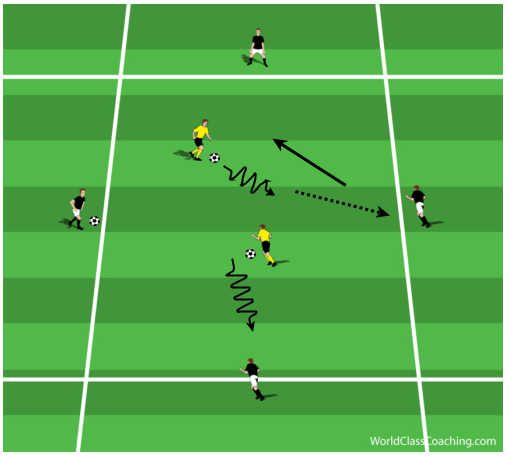
Set Up
- Using the example above. Set up with an area of approx 25yd x 25yd, 4 players on the outside, with 2 players on the inside the area. 3 balls
- The 2 players in the middle remain in the middle for a period of 20-30secs
- Balls start on the outside, the players in the middle working looking to receive the ball, then play out to a spare player on the outside
- The player must make a movement before they receive the next ball (could put a box or line across the pitch to encourage them to receive in another area)
- If you have more numbers or less then you can change the number inside and outside and also the number of balls being used.
Coaching Points
- Movement to receive the ball
- Body shape when receiving and 1st touch
- Awareness of spare player which will influence 1st touch
- Change of pace
- Quality of end product
- Communication
Objective: Session 2
Supporting and providing a good angle to the player on the ball
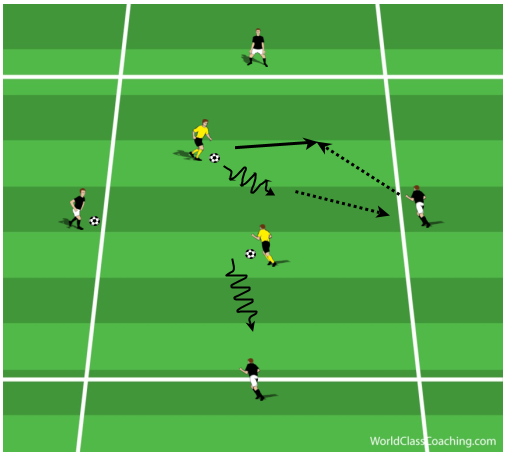
Set Up
- The same set up as the previous session with the players on the inside and the outside.
- When the player makes their 1st pass out to a spare player, they then make a 2nd movement to receive the ball from the player they have played out to.
- They will then pass that ball out, then look for a new ball
- As they play the 1st pass out, the player can tell the outside player to hold the ball whilst they make a new angle. They will then look to receive the ball, allowing it to come across their body without touching it
- You could introduce 2 pairs to work in the middle depending on numbers, otherwise put in some mannequins or poles to encourage players to work through the traffic
Coaching Points
- As above within the previous session
- Movement to create a new angle receive the ball
- Scan prior to receiving the ball
- Open body shape to allow the ball to come across, knowing there is space to open out into
Objective: Session 3
Encourage the awareness of not only the players inside the area but the players on the outside. Working on them to support and provide good angles.
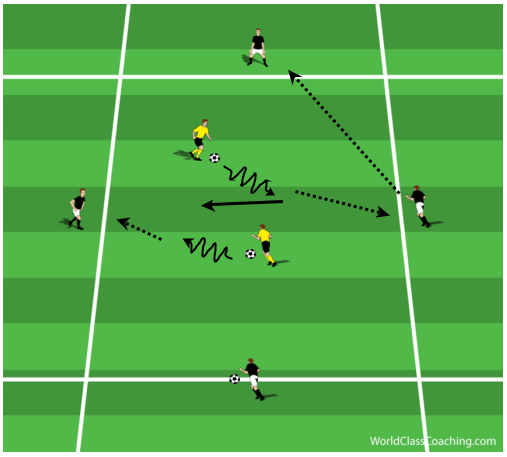
Set Up
- As within the previous session.
- Depending on how the players are working, you can always remove a ball to avoid any problems or if you only started with 2 balls, introduce an additional ball to challenge them.
- When the ball is played to a player on the outside and that player in the inside has gone to look for a new ball. The player on the outside can play make one pass to another player on the outside. This will then encourage the spare man to change and the players in the middle will need to recognize that. Plus, it encourages the players on the outside to always be aware not only central but peripherally.
- Players on the outside are supporting the ball working up and down the line
Coaching Points
- As with previous sessions
- Awareness with be challenged and therefore players will need to concentrate. Awareness before and whilst they receive the ball
- Might need to encourage the player in the middle to stay on the ball a little longer as the outside options change
Objective: Session 4
Encourage creating triangles, supporting the ball and movement to receive the ball
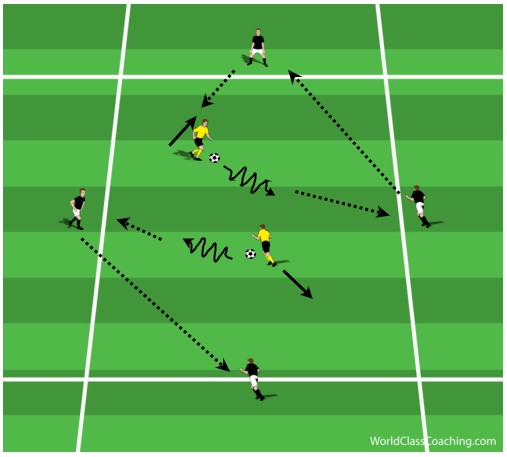
Set Up
- As with the previous sessions
- Use only 2 balls
- When the player on the ball in the area plays to the outside player, the outside player receiving the ball will look to immediately pass to someone else on the outside. They will then play a pass back into the player in the middle.
- The player in the middle will then stay on the ball until the next opportunity is available to play to the outside and the process is repeated.
Coaching Points
- As in the previous sessions
- Creating that triangle of support
- Tempo of play
- Angle of support
- Decision to play 1st time or take touches
- Movement to receive the 2nd ball
Progressions / Options
Please note the diagram below illustrates the option to use Mannequins / poles or even areas for players to work around, within or through. This will encourage the movement and awareness especially if you have limited players. Ideally you want players working around and within each other as oppose to static and immoveable objectives. You need the environment to challenge and replicate the demands of the game. Other options could include reducing the size of the area and the number of balls used.
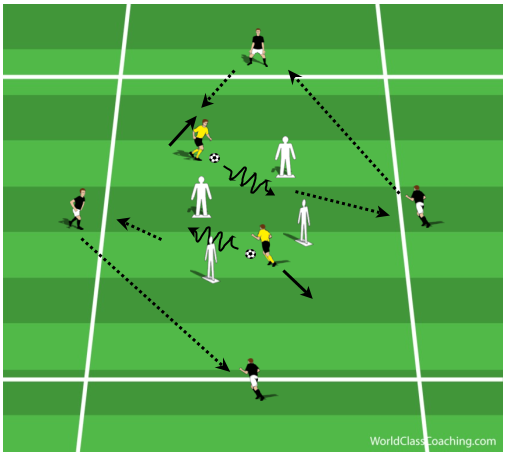
By Sean Reed
Former First Team Coach of Championship side Fulham FC. Sean is a UEFA A Coach with a Masters in Sport Coaching. He has over 15 years of experience working in professional football from Academy through to First team in the Premiership and Championship.
Linkedin - www.developmentofplayers.com
Twitter - @SeanJReed


